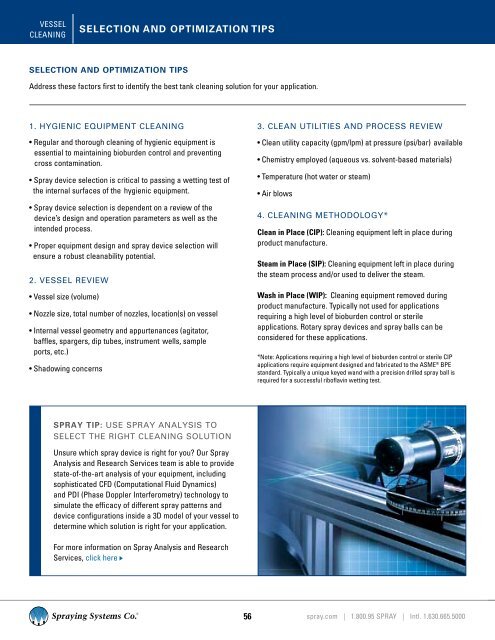VESSEL CLEANING - Spraying Systems Co.
VESSEL CLEANING - Spraying Systems Co.
VESSEL CLEANING - Spraying Systems Co.
Create successful ePaper yourself
Turn your PDF publications into a flip-book with our unique Google optimized e-Paper software.
Vessel<br />
CleaninG<br />
SELECTION AND OPTIMIZATION TIPS<br />
SELECTION AND OPTIMIZATION TIPS<br />
Address these factors first to identify the best tank cleaning solution for your application.<br />
1. hygienic equipment cleaning<br />
• Regular and thorough cleaning of hygienic equipment is<br />
essential to maintaining bioburden control and preventing<br />
cross contamination.<br />
• Spray device selection is critical to passing a wetting test of<br />
the internal surfaces of the hygienic equipment.<br />
• Spray device selection is dependent on a review of the<br />
device’s design and operation parameters as well as the<br />
intended process.<br />
• Proper equipment design and spray device selection will<br />
ensure a robust cleanability potential.<br />
2. <strong>VESSEL</strong> REVIEW<br />
• Vessel size (volume)<br />
• Nozzle size, total number of nozzles, location(s) on vessel<br />
• Internal vessel geometry and appurtenances (agitator,<br />
baffles, spargers, dip tubes, instrument wells, sample<br />
ports, etc.)<br />
• Shadowing concerns<br />
3. CLEAN UTILITIES AND PROCESS REVIEW<br />
• Clean utility capacity (gpm/lpm) at pressure (psi/bar) available<br />
• Chemistry employed (aqueous vs. solvent-based materials)<br />
• Temperature (hot water or steam)<br />
• Air blows<br />
4. <strong>CLEANING</strong> METHODOLOGY*<br />
Clean in Place (CIP): Cleaning equipment left in place during<br />
product manufacture.<br />
Steam in Place (SIP): Cleaning equipment left in place during<br />
the steam process and/or used to deliver the steam.<br />
Wash in Place (WIP): Cleaning equipment removed during<br />
product manufacture. Typically not used for applications<br />
requiring a high level of bioburden control or sterile<br />
applications. Rotary spray devices and spray balls can be<br />
considered for these applications.<br />
*Note: Applications requiring a high level of bioburden control or sterile CIP<br />
applications require equipment designed and fabricated to the ASME ® BPE<br />
standard. Typically a unique keyed wand with a precision drilled spray ball is<br />
required for a successful riboflavin wetting test.<br />
Spray Tip: USE SPRAY ANALYSIS TO<br />
SELECT THE RIGHT <strong>CLEANING</strong> SOLUTION<br />
Unsure which spray device is right for you? Our Spray<br />
Analysis and Research Services team is able to provide<br />
state-of-the-art analysis of your equipment, including<br />
sophisticated CFD (<strong>Co</strong>mputational Fluid Dynamics)<br />
and PDI (Phase Doppler Interferometry) technology to<br />
simulate the efficacy of different spray patterns and<br />
device configurations inside a 3D model of your vessel to<br />
determine which solution is right for your application.<br />
For more information on Spray Analysis and Research<br />
Services, click here<br />
56 spray.com | 1.800.95 SPRAY | Intl. 1.630.665.5000

















